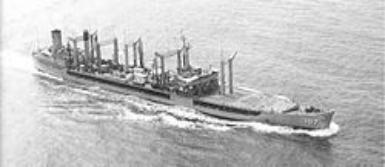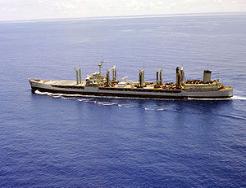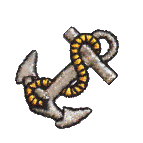USS Passumpsic (AO-107) History
USS Passumpsic (AO-107), the only United States Navy ship to
bear the name, was a Mispillion class fleet replenishment oiler that served in
the U.S. Navy from 1946 to 1973, then transferred to the Military Sealift
Command to continue service as a United States Naval Ship USNS
Passumpsic (T-AO-107). She was the only Navy ship to bear the name
Passumpsic, after the Passumpsic River in Vermont.
Construction and commissioning
USS Passumpsic (AO-107) was laid down on 8 March 1945 as Maritime
Commission Hull 2703 by Sun Shipbuilding and Drydock Company, Chester,
Pennsylvania. She was launched on 31 October 1945, sponsored by Mrs. M.
F. Draemel, wife of Rear Admiral Milo F. Draemel, then Commandant of the
4th Naval District, and commissioned on 1 April 1946, Captain C.M. Ryan in
command. Because of beginning as a "Maritime" Hull, Passumpsic has the
distinction of being one of only six naval ships to have her Frame numbers
running from Aft - Forward, instead of Forward to Aft.
Service career, 1946–64
After a shakedown in the Caribbean Sea, Passumpsic operated out of Long
Beach, California, under the control of Commander, Service Force Pacific,
servicing U.S. Pacific Fleet units while attached to Service Squadrons 1 and
3. She visited Japan, Taiwan, Korea, Southeast Asia,Hong Kong, North
Borneo, the Fiji Islands, Australia, Arabia, Ceylon, the Philippines, Midway
Atoll, Oahu, the Marshall and the Mariana Islands.
USS Passumpsic as built
From June 1950 through February 1954, Passumpsic spent 34 of 44 months
outside of the United States. Though not subjected to hostile fire during the
Korean War, Passumpsic received nine battlestars for her Korean War
service.
Passumpsic’s assignments after the Korean War entailed annual
deployments to the Western Pacific.
"Jumboization"
Upon return from deployment in April 1964, Passumpsic underwent an
INSURV Board inspection at Long Beach Naval Shipyard in preparation for
"Jumboization," a project of modernization and renovation for Mispillion-class
fleet oilers. She steamed on 12 October 1964 for the American Shipbuilding
Company yard at Lorain, Ohio, where the conversion was to take place. At
Boston Naval Shipyard a Supply Overhaul Assistance Program (SOAP) was
set up to sort, identify, and repackage the ship’s stock of repair parts and to
receive, sort, and stow the repair parts supplied by the contractor and the U.
S. Navy in conjunction with the conversion programs. After passage through
the Panama Canal and St. Lawrence Seaway, Passumpsic was placed "in
commission, in reserve". On 26 November 1964 most of her crew detached,
leaving a nucleus party of four officers and 28 enlisted men under the
command of Lcdr. James. K. Beates. The ship was turned over to the
American Shipbuilding Company.
The conversion involved transferring her existing midships superstructure to
a newly constructed tank section. The original hull was cut and the bow and
stern sections were added to the new tank section. Conversion modifidations
increased Passumpsic's length by 91 feet (28 m), her light displacement from
7,423 tons to 12,840 tons, her full-load displacement from 25,500 to 34,350
tons, and her maximum draft from 32 feet (9.75 m) to 36 feet (11 m).
Passumpsic departed Lorain on 22 November 1965 with a merchant marine
master and civilian crew. She arrived at the Boston Army Base piers, South
Boston, Massachusetts, on 1 December 1965.
USS Passumpsic after completion of
"jumboization"
Accepted by the U.S. Navy at Boston, on 10 January 1966, Passumpsic fitted
out at Boston Naval Shipyard throughout February and into March, departing
5 March 1966 for Norfolk, Virginia, to load oil and for degaussing inspection.
bear the name, was a Mispillion class fleet replenishment oiler that served in
the U.S. Navy from 1946 to 1973, then transferred to the Military Sealift
Command to continue service as a United States Naval Ship USNS
Passumpsic (T-AO-107). She was the only Navy ship to bear the name
Passumpsic, after the Passumpsic River in Vermont.
Construction and commissioning
USS Passumpsic (AO-107) was laid down on 8 March 1945 as Maritime
Commission Hull 2703 by Sun Shipbuilding and Drydock Company, Chester,
Pennsylvania. She was launched on 31 October 1945, sponsored by Mrs. M.
F. Draemel, wife of Rear Admiral Milo F. Draemel, then Commandant of the
4th Naval District, and commissioned on 1 April 1946, Captain C.M. Ryan in
command. Because of beginning as a "Maritime" Hull, Passumpsic has the
distinction of being one of only six naval ships to have her Frame numbers
running from Aft - Forward, instead of Forward to Aft.
Service career, 1946–64
After a shakedown in the Caribbean Sea, Passumpsic operated out of Long
Beach, California, under the control of Commander, Service Force Pacific,
servicing U.S. Pacific Fleet units while attached to Service Squadrons 1 and
3. She visited Japan, Taiwan, Korea, Southeast Asia,Hong Kong, North
Borneo, the Fiji Islands, Australia, Arabia, Ceylon, the Philippines, Midway
Atoll, Oahu, the Marshall and the Mariana Islands.
USS Passumpsic as built
From June 1950 through February 1954, Passumpsic spent 34 of 44 months
outside of the United States. Though not subjected to hostile fire during the
Korean War, Passumpsic received nine battlestars for her Korean War
service.
Passumpsic’s assignments after the Korean War entailed annual
deployments to the Western Pacific.
"Jumboization"
Upon return from deployment in April 1964, Passumpsic underwent an
INSURV Board inspection at Long Beach Naval Shipyard in preparation for
"Jumboization," a project of modernization and renovation for Mispillion-class
fleet oilers. She steamed on 12 October 1964 for the American Shipbuilding
Company yard at Lorain, Ohio, where the conversion was to take place. At
Boston Naval Shipyard a Supply Overhaul Assistance Program (SOAP) was
set up to sort, identify, and repackage the ship’s stock of repair parts and to
receive, sort, and stow the repair parts supplied by the contractor and the U.
S. Navy in conjunction with the conversion programs. After passage through
the Panama Canal and St. Lawrence Seaway, Passumpsic was placed "in
commission, in reserve". On 26 November 1964 most of her crew detached,
leaving a nucleus party of four officers and 28 enlisted men under the
command of Lcdr. James. K. Beates. The ship was turned over to the
American Shipbuilding Company.
The conversion involved transferring her existing midships superstructure to
a newly constructed tank section. The original hull was cut and the bow and
stern sections were added to the new tank section. Conversion modifidations
increased Passumpsic's length by 91 feet (28 m), her light displacement from
7,423 tons to 12,840 tons, her full-load displacement from 25,500 to 34,350
tons, and her maximum draft from 32 feet (9.75 m) to 36 feet (11 m).
Passumpsic departed Lorain on 22 November 1965 with a merchant marine
master and civilian crew. She arrived at the Boston Army Base piers, South
Boston, Massachusetts, on 1 December 1965.
USS Passumpsic after completion of
"jumboization"
Accepted by the U.S. Navy at Boston, on 10 January 1966, Passumpsic fitted
out at Boston Naval Shipyard throughout February and into March, departing
5 March 1966 for Norfolk, Virginia, to load oil and for degaussing inspection.


Passumpsic departed Norfolk on 11 March 1966 for her home port of Long Beach, California, arriving there on 6 April 1966.
Final U.S. Navy acceptance came on 24 August 1966, and she was designated a ready unit under Commander Task Group
13.1 (CTG 13.1) on 1 September 1966.
1966–73
Passumpsic departed Long Beach on 22 September 1966 and arrived at Subic Bay in the Philippine Islands on 15 October
1966. From Subic Bay the oiler steamed on replenishment operations off the coasts of North Vietnam and South Vietnam.
She continued to service U.S. Navy units in the Western Pacific until May 1967, when she returned to her home port.
Passumpsic departed Long Beach in November 1967 for the Western Pacific and again operated from Subic Bay to serve
ships operating in the Vietnam War combat zone and making port visits between underway replenishment assignments. She
returned to Long Beach in June 1968.
In November 1968 Passumpsic again deployed to the Western Pacific to operate out of Subic Bay in support of ships
operating off of Vietnam. She returned to Long Beach 27 June 1969 for yard availability, local training operations, and
preparations for her next Western Pacific deployment.
Passumpsic remained in commissioned service with the U.S. Navy until 1973, although her activities between mid-1969 and
1973 are not readily available and await further research.
On 24 July 1973, Passumpsic was decommissioned. She transferred to the Military Sealift Command on the same day,
becoming United States Naval Ship, USNS Passumpsic (T-AO-107). Under this new designation, she continued in service in
support of the U.S. Navy with a civilian crew from 1975 until 1991.
Later career and disposition
Passumpsic began active service with the Military Sealift Command in 1975. One of her first tasks was a three month
deployment from Subic Bay as part of the 1975-1976 Indian Ocean task group. The task group consisted of the USS Fox
(CG-33), USS Gray (FF-1054) and USS Hepburn (FF-1055). The task group was replenished in the Arabian Sea by USS
White Plains. At the end of her career, she supported ships operating in Operation Desert Storm in Iraq in 1991.
Passumpsic was in Subic Bay at Luzon in the Philippine Islands when Mount Pinatubo erupted in 1991, suffering extensive
damage to her Underway Replenishment gear caused by a mixture of volcanic ash and rain water from a passing typhoon.
Passumpsic was stricken from the Navy List in December 1991; sources differ on whether the date was 17 December 1991
or 18 December 1991 She was sold to a Singaporean firm for scrapping on 19 December 1991. She was resold to an Indian
firm on 1 July 1992 for scrapping in India.
Final U.S. Navy acceptance came on 24 August 1966, and she was designated a ready unit under Commander Task Group
13.1 (CTG 13.1) on 1 September 1966.
1966–73
Passumpsic departed Long Beach on 22 September 1966 and arrived at Subic Bay in the Philippine Islands on 15 October
1966. From Subic Bay the oiler steamed on replenishment operations off the coasts of North Vietnam and South Vietnam.
She continued to service U.S. Navy units in the Western Pacific until May 1967, when she returned to her home port.
Passumpsic departed Long Beach in November 1967 for the Western Pacific and again operated from Subic Bay to serve
ships operating in the Vietnam War combat zone and making port visits between underway replenishment assignments. She
returned to Long Beach in June 1968.
In November 1968 Passumpsic again deployed to the Western Pacific to operate out of Subic Bay in support of ships
operating off of Vietnam. She returned to Long Beach 27 June 1969 for yard availability, local training operations, and
preparations for her next Western Pacific deployment.
Passumpsic remained in commissioned service with the U.S. Navy until 1973, although her activities between mid-1969 and
1973 are not readily available and await further research.
On 24 July 1973, Passumpsic was decommissioned. She transferred to the Military Sealift Command on the same day,
becoming United States Naval Ship, USNS Passumpsic (T-AO-107). Under this new designation, she continued in service in
support of the U.S. Navy with a civilian crew from 1975 until 1991.
Later career and disposition
Passumpsic began active service with the Military Sealift Command in 1975. One of her first tasks was a three month
deployment from Subic Bay as part of the 1975-1976 Indian Ocean task group. The task group consisted of the USS Fox
(CG-33), USS Gray (FF-1054) and USS Hepburn (FF-1055). The task group was replenished in the Arabian Sea by USS
White Plains. At the end of her career, she supported ships operating in Operation Desert Storm in Iraq in 1991.
Passumpsic was in Subic Bay at Luzon in the Philippine Islands when Mount Pinatubo erupted in 1991, suffering extensive
damage to her Underway Replenishment gear caused by a mixture of volcanic ash and rain water from a passing typhoon.
Passumpsic was stricken from the Navy List in December 1991; sources differ on whether the date was 17 December 1991
or 18 December 1991 She was sold to a Singaporean firm for scrapping on 19 December 1991. She was resold to an Indian
firm on 1 July 1992 for scrapping in India.
From Wikipedia, the free encyclopedia
| Web Master Robert H. Brockman MMC USN Ret |

